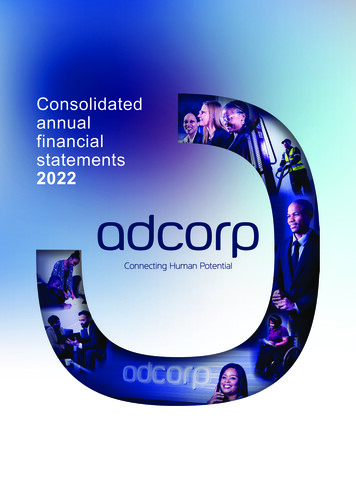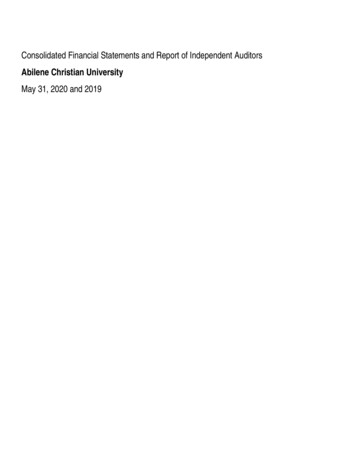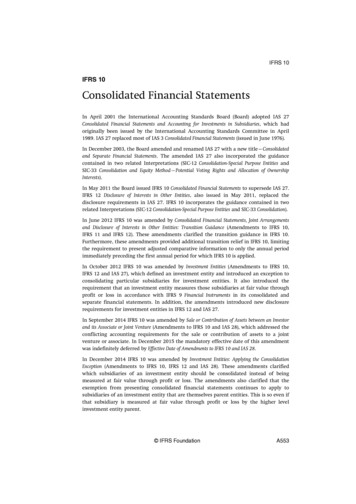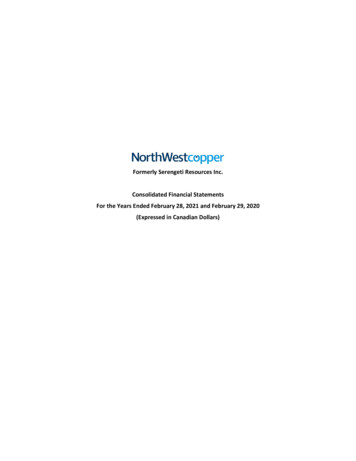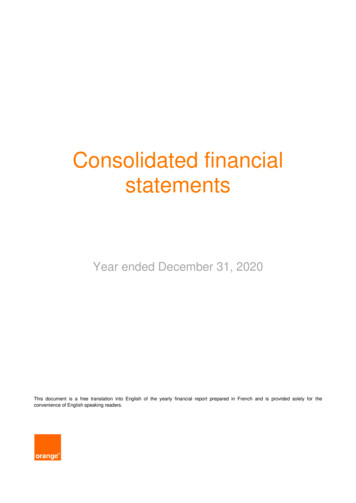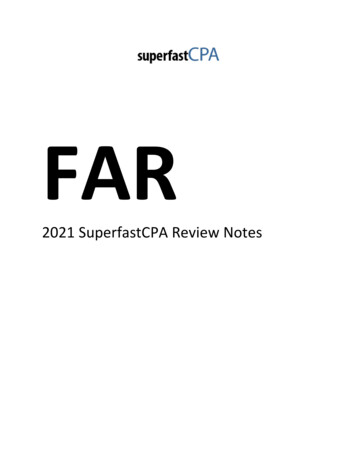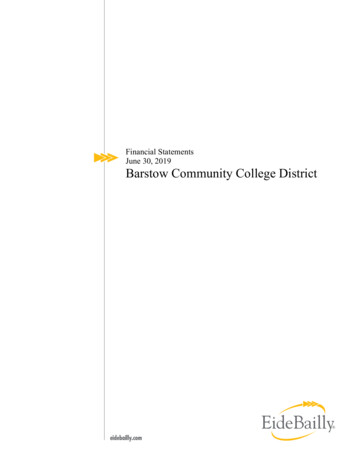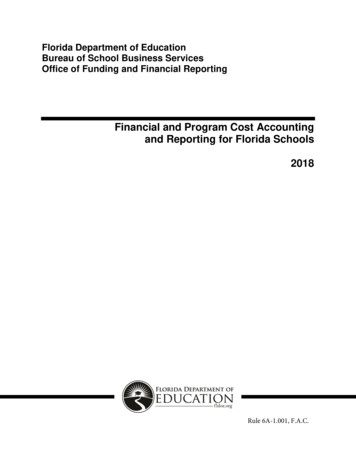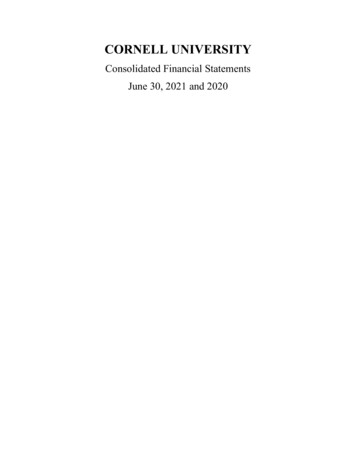
Transcription
CORNELL UNIVERSITYConsolidated Financial StatementsJune 30, 2021 and 2020
Report of Independent AuditorsTo The Board of Trustees of Cornell UniversityWe have audited the accompanying consolidated financial statements of Cornell University (the “University”),which comprise the consolidated statements of financial position as of June 30, 2021 and 2020 and the relatedconsolidated statements of activities for the year ended June 30, 2021 and of cash flows for the years ended June 30,2021 and 2020.Management's Responsibility for the Consolidated Financial StatementsManagement is responsible for the preparation and fair presentation of the consolidated financial statements inaccordance with accounting principles generally accepted in the United States of America; this includes the design,implementation, and maintenance of internal control relevant to the preparation and fair presentation of consolidatedfinancial statements that are free from material misstatement, whether due to fraud or error.Auditors’ ResponsibilityOur responsibility is to express an opinion on the consolidated financial statements based on our audits. Weconducted our audits in accordance with auditing standards generally accepted in the United States of America.Those standards require that we plan and perform the audit to obtain reasonable assurance about whether theconsolidated financial statements are free from material misstatement.An audit involves performing procedures to obtain audit evidence about the amounts and disclosures in theconsolidated financial statements. The procedures selected depend on our judgment, including the assessment of therisks of material misstatement of the consolidated financial statements, whether due to fraud or error. In makingthose risk assessments, we consider internal control relevant to the University's preparation and fair presentation ofthe consolidated financial statements in order to design audit procedures that are appropriate in the circumstances,but not for the purpose of expressing an opinion on the effectiveness of the University's internal control.Accordingly, we express no such opinion. An audit also includes evaluating the appropriateness of accountingpolicies used and the reasonableness of significant accounting estimates made by management, as well as evaluatingthe overall presentation of the consolidated financial statements. We believe that the audit evidence we haveobtained is sufficient and appropriate to provide a basis for our audit opinion.OpinionIn our opinion, the consolidated financial statements referred to above present fairly, in all material respects, thefinancial position of Cornell University as of June 30, 2021 and 2020 and the changes in their net assets for the yearended June 30, 2021 and their cash flows for the years ended June 30, 2021 and 2020 in accordance with accountingprinciples generally accepted in the United States of America.Other MatterWe previously audited the consolidated statement of financial position as of June 30, 2020, and the relatedconsolidated statements of activities and cash flows for the year then ended (the statement of activities is notpresented herein), and in our report dated October 8, 2020, we expressed an unmodified opinion on thoseconsolidated financial statements. In our opinion, the information set forth in the accompanying summarizedfinancial information as of June 30, 2020 and for the year then ended is consistent, in all material respects, with theaudited consolidated financial statements from which it has been derived.Rochester, New YorkOctober 22, 20212
CORNELL UNIVERSITYCONSOLIDATED STATEMENTS OF FINANCIAL POSITIONAS OF JUNE 30, 2021 AND JUNE 30, 2020 (in thousands)20212020AssetsCash and cash equivalents 744,927 591,483Accounts receivable, net (note 3-A)611,571518,153Contributions receivable, net (note 3-B)778,171778,599Prepaid expenses and other assets142,739134,02410,603,4287,813,510Right of use assets-operating leases, net (note 10)448,191465,124Right of use assets-finance leases, net (note 10)111,456114,0364,314,4954,286,656152,751149,033 17,907,729 14,850,618 Investments (note 4)Land, buildings, and equipment, net (note 5)Funds held in trust by others (note 6)Total assetsLiabilitiesAccounts payable and accrued expenses770,997803,826Deferred revenue and other liabilities270,292276,763Obligations under split interest agreements (note 6)137,099136,909Deferred benefits (note 7)688,760703,716Funds held for others (note 8)133,410100,436Operating lease liabilities (note 10)458,617467,971Finance lease liabilities (note 10)121,949121,6831,876,7301,918,482 4,457,854 4,529,786Without donor restrictions3,833,1013,029,185With donor restrictions9,616,7747,291,64713,449,87510,320,832 17,907,729 14,850,618Bonds and notes payable (note 9)Total liabilitiesNet assets (note 12)Total net assetsTotal liabilities and net assetsThe accompanying notes are an integral part of the consolidated financial statements.3
CORNELL UNIVERSITYCONSOLIDATED STATEMENTS OF ACTIVITIES FOR THE YEAR-ENDED JUNE 30, 2021 (in thousands)(WITH SUMMARIZED INFORMATION FOR THE YEAR-ENDED JUNE 30, 2020)Without DonorWith rating revenues and other supportTuition and fees (scholarship allowance 453,214 and 435,911) 792,381 - 792,381 697,317Indirect cost --State and federal appropriationsGrants, contracts and similar agreementsContributionsInvestment return, distributedM edical Phy sician OrganizationAuxiliary enterprisesEducational activities and other sales andservices730,657Net assets released from restrictions586,153Total operating revenues and other ompensation and benefits3,060,643-3,060,6432,995,105Supplies, services and other961,148-961,1481,037,938M aintenance and )Operating expenses (Note 11)Interest (note 9)DepreciationTotal operating expensesChange in net assets from operatingactivitiesNon-operating revenues and (expenses)State appropriations for capital acquisitionsGrants, contracts and similar agreements forcapital acquisitionsContributions for capital acquisitions,trusts and endowmentsInvestment return, net of amountdistributedChange in value of split interest agreementsPension and postretirement changesSwap interest and change in value ofinterest rate swapsOtherNet assets released for capital acquisitionsand reclassificationsChange in net assets from non-operatingactivitiesChange in net assetsNet assets, beginning of the yearNet assets, end of the 710,320,83210,633,665 3,833,101 9,616,774 13,449,875 10,320,832The accompanying notes are an integral part of the consolidated financial statements.4(312,833)
CORNELL UNIVERSITYCONSOLIDATED STATEMENTS OF CASH FLOWSFOR THE YEARS-ENDED JUNE 30, 2021 AND JUNE 30, 2020 (in thousands)2021Cash flows from operating activitiesChange in net assetsAdjustments to reconcile change in net assetsto net cash provided/(used) by operating activitiesProceeds from contributions for capital acquisitions, trusts and endowmentsDepreciation and amortizationNet realized and unrealized (gain)/loss on investmentsPension and postretirement changesChange in unrealized (gain)/loss interest rate swaps(Gain)/loss on extinguishment of debtLoss on disposals of land, building, and equipmentNon-cash lease expenseState appropriations for capital acquisitionsOther adjustmentsChange in assets and liabilitiesAccounts receivable, net, other than student loansContributions receivable, netPrepaid expenses and other assetsAccounts payable and accrued expensesDeferred revenue and other liabilitiesFunds held in trust by othersObligations under split interest agreementsDeferred benefitsNet cash provided/(used) by operating activitiesCash flows from investing activitiesProceeds from the sale and maturities of investmentsPurchase of investmentsAcquisition of land, buildings, and equipment (net)Student loans grantedStudent loans repaidChange in funds held for others, net of unrealized (gain)/loss on investmentsNet cash used by investing activitiesCash flows from financing activitiesProceeds from contributions for capital acquisitions, trusts and endowmentsProceeds from state appropriations for capital acquisitionsPrincipal payments of bonds, notes payable and finance leasesProceeds from issuance of bonds and notes payableGain/(loss) on extinguishment of debtGovernment advances for student loansNet cash provided by financing activitiesNet change in cash and cash equivalentsCash and cash equivalents, beginning of yearCash and cash equivalents, end of yearS upplemental disclosure of cash flow informationCash paid for interestIncrease/(decrease) in construction payables, non-cash activityRight-of-use assets acquired under finance leasesRight-of-use assets acquired under operating leasesGifts-in-kindThe accompanying notes are an integral part of the consolidated financial statements.5 3,129,0432020 2)296,523153,444591,483 744,927 944234,539591,483 924,805
Cornell UniversityNotes to Consolidated Financial Statements (dollars in thousands)June 30, 2021 and 20201. SIGNIFICANT ACCOUNTING POLICIESA. Description of the OrganizationFounded in 1865, Cornell University (“the University”) is dedicated to a mission of learning,discovery, and engagement. Cornell is a private university, the federal land-grant institution ofNew York State, and a member of the Ivy League. Cornell administers four contract colleges,which the University operates on behalf of the State University of New York. Described as thefirst truly American university because of its founders’ revolutionary egalitarian and practicalvision of higher education, the University is dedicated to its land-grant mission of outreach andpublic engagement. Cornell’s community includes nearly 24,900 students, over 4,600 faculty,and approximately 298,000 alumni who live and work across the globe.The University comprises seven undergraduate units and four graduate and professional collegesand schools in Ithaca, New York; two medical graduate and professional units, together with itsphysician organization, collectively referred to as “Weill Cornell Medicine” or “WCM”, in NewYork City, and the “Weill Cornell Medicine - Qatar” in Doha, Qatar. The Cornell Tech campus,also in New York City, offers graduate programs in applied sciences, including three programsoffered jointly with the Technion - Israel Institute of Technology under the auspices of the Joanand Irwin Jacobs Technion-Cornell Institute.The University is subject to the common administrative authority and control of the CornellUniversity Board of Trustees. The University is prohibited from using funds attributable to thecontract colleges (i.e., those colleges operated by the University on behalf of New York State)for other units of the University. Except as specifically required by law, the contract andendowed colleges at Ithaca, Cornell Tech, and WCM are, to the extent practicable, governed bycommon management principles and policies determined at the private discretion of theUniversity. In addition to the activities of the endowed and contract colleges, the activities of theUniversity’s subsidiaries and certain affiliated organizations are included in the consolidatedfinancial statements. All significant intercompany transactions and balances are eliminated in theaccompanying consolidated financial statements.B. Basis of PresentationThe accompanying consolidated financial statements are prepared in accordance with U.S.generally accepted accounting principles (“GAAP”). Net assets, revenues, gains, and losses arecategorized based on the existence or absence of donor-imposed restrictions.The University’s Board of Trustees, with consideration to the actions, reports, information,advice, and counsel provided by its duly constituted committees and appointed officers of theUniversity, including University Counsel, has instructed the University to preserve the historicaldollar value of donor-restricted (true) endowment funds, absent explicit donor direction to thecontrary. As a result, the University classifies as net assets with donor restrictions the originalgift value of true endowments, plus any subsequent gifts and accumulations made in accordancewith the directions of the applicable gift instruments.Net assets with donor restrictions also include gifts and appropriations from the endowment thatcan be expended, but for which the donors’ purpose restrictions have not yet been met, as well as6
Cornell UniversityNotes to Consolidated Financial Statements (dollars in thousands)June 30, 2021 and 2020net assets with explicit or implied time restrictions, such as pledges and split-interest agreements.Expiration of donor restrictions is reported in the consolidated statements of activities as areclassification from net assets with donor restrictions to net assets without donor restrictions onthe net assets released from restriction lines. Net assets without donor restrictions are theremaining net assets of the University.The University’s measure of operations as presented in the consolidated statements of activitiesincludes revenue and expenses related primarily to educational and training programs, researchactivities, contributions for operating programs, allocation of endowment spending foroperations, medical services, and other revenues.The University’s non-operating activity within the consolidated statements of activities includesgrants, contracts and appropriations for capital acquisition; contributions to the endowment andfor building construction and renovation; investment returns and other activities related to theendowment; long-term benefit plan obligation; funding changes, and certain nonrecurring items.The preparation of the consolidated financial statements in conformity with U.S. GAAP requiresmanagement to make estimates and assumptions that affect the reported amounts of assets,liabilities, revenues, and expenses during the reporting period. Management’s assumptions arerelated primarily to the appropriate inputs and discount rate for fair-value calculations, thediscount rate for pension and postretirement benefit obligations, allowances for doubtfulaccounts and implicit price concessions, and self-insured risks. Actual results may differ fromthose estimates.C. Income TaxesThe University is a not-for-profit organization as described in Section 501(c)(3) of the InternalRevenue Code. It is generally exempt from income taxes on related income under theappropriate sections of the Internal Revenue Code. In accordance with the accounting standards,the University evaluates its income tax position each fiscal year to determine whether theposition is more likely than not to be sustained if examined by the applicable taxing authority.This review had no material impact on the University’s consolidated financial statements.D. Fair-Value HierarchyThe University values certain financial assets and liabilities, on a recurring basis, following ahierarchy that categorizes and prioritizes the sources used to measure and disclose fair value.Fair value is defined as the price associated with an orderly transaction between marketparticipants at the measurement date. This fair-value hierarchy is categorized into three levelsbased on inputs that market participants would use in valuing the financial instruments, which isbased on market data obtained from sources independent of the University. The hierarchy ofinputs used to measure fair value, and the primary valuation methodologies used by theUniversity for assets and liabilities measured at fair value, are disclosed below.The fair value of Level 1 securities is based upon quoted prices in accessible active markets foridentical assets. Market price data is generally obtained from exchange or dealer markets. TheUniversity does not adjust the quoted price for such assets.7
Cornell UniversityNotes to Consolidated Financial Statements (dollars in thousands)June 30, 2021 and 2020The fair value of Level 2 securities is determined using multiple valuation techniques includingthe market approach, income approach, or cost approach. It is based upon quoted prices forsimilar instruments in active markets, quoted prices for identical or similar instruments inmarkets that are not active, and model-based valuation techniques for which all significantassumptions are observable in the market or can be corroborated by observable market data.Inputs are obtained from various sources, including market participants, dealers, and brokers. Indetermining the fair value of financial instruments, the University considers such factors asinterest-rate yield curves, duration of the instrument, and counterparty credit risk. The fair valueof Level 3 securities is based upon valuation techniques that use significant unobservable inputs.Inputs used in applying the various valuation techniques refer to the assumptions that are used tomake valuation decisions. Inputs may include price information, credit data, liquidity statistics,and other factors. A financial instrument’s level within the fair-value hierarchy is based on thelowest level of any input that is significant to the fair-value measurement. The Universityconsiders observable data to be market data that is readily available, reliable, and provided byindependent sources. The categorization of a financial instrument within the fair-value hierarchyis, therefore, based upon the pricing transparency of the instrument and does not correspond tothe University’s perceived risk of that instrument.E. Cash and Cash EquivalentsCash and cash equivalents include cash on hand and in bank accounts, money market funds, andother temporary investments held for working capital purposes with an original maturity term ofninety days or less. The carrying amount of cash equivalents approximates fair value because oftheir short terms of maturity. Short-term highly liquid investments held within the University'sinvestment portfolio are classified as short-term investments rather than cash equivalents andrestricted cash is defined as that which is legally restricted to withdrawal and usage.F. InvestmentsThe University’s investments are recorded in the consolidated financial statements at fair value.The values of publicly traded securities are based on quoted market prices and exchange rates, ifapplicable. The fair value of non-marketable securities is based on valuations provided byexternal investment managers. These investments are generally less liquid than otherinvestments. The values reported by the general partner or investment manager may differ fromthe values that would have been reported had a ready market for these securities existed. TheUniversity exercises due diligence in assessing the policies, procedures, and controlsimplemented by its external investment managers and believes the carrying amount of theseassets is a reasonable estimate of fair value.Investment income is recorded on an accrual basis. Purchases and sales of investment securitiesare reflected on a trade date basis. Realized gains and losses are calculated using average cost forsecurities sold.Investment return included in operating revenues and other support consists of amountsappropriated by the Board of Trustees from the pooled endowment, as well as income andrealized gains and losses on investments from working capital and non-pooled endowments andsimilar funds. Any difference between total return and amounts appropriated from the pooled8
Cornell UniversityNotes to Consolidated Financial Statements (dollars in thousands)June 30, 2021 and 2020endowment, and income and realized gains reinvested per donor restrictions are reported as nonoperating activities.G. Derivative InstrumentsThe University has approved the use of derivatives by outside investment managers, based oninvestment guidelines negotiated when a manager is appointed. The derivatives are used to adjustfixed-income durations and rates, create synthetic exposures to certain types of investments,hedge foreign currency fluctuations as well as adjust or hedge equity exposures. The value ofthese derivative positions is reflected in the net asset value of the respective fund. The change inthe fair value of a derivative instrument held for investment is included in the non-operatinginvestment return in the consolidated statements of activities.In addition, the University holds other derivatives to manage its exposure to interest-rate riskrelated to its current or future long-term debt. These instruments are recorded at fair value asprepaid or accrued expenses in the consolidated statements of financial position. Swap interestand change(s) in fair value are recorded as non-operating activities in the consolidated statementsof activities.Derivatives involve counterparty credit exposure. The University minimizes this exposure andmanages counterparty risks by limiting swap exposure for each counterparty and monitoring thefinancial health of swap counterparties. The University has structured swap documents to limitmaximum loss in the event of counterparty default.H. EndowmentsThe responsibility for accepting, preserving, and managing those funds entrusted to theUniversity rests, by law, with the Board of Trustees; however, the Trustees have delegatedauthority for investment decisions to the Investment Committee of the Board of Trustees. TheInvestment Committee determines investment policy, objectives, and guidelines, includingallocation of assets between classes of investments.The University’s investment objective for its endowment assets is to maximize total returnwithin reasonable risk parameters, specifically to achieve a total return, net of expenses, of atleast five percent above inflation, as measured by the Consumer Price Index over rolling fiveyear periods. The achievement of favorable investment returns enables the University todistribute over time increasing amounts from the endowment, so that present and future needscan be treated equitably in inflation-adjusted terms. Diversification is a key component of theUniversity’s standard for managing and investing endowment funds, and asset allocation targetsare subject to ongoing reviews by the Investment Committee.The University applies the “prudent person” standard when deciding whether to appropriate oraccumulate endowment funds and considers the following factors: the duration and preservationof the endowment fund; the purposes of the institution and the endowment fund; the generaleconomic conditions, including the potential effect of inflation or deflation; the expected totalreturn of the fund; other resources of the University; the needs of the University and the fund tomake distributions and preserve capital; and the University’s investment policy.9
Cornell UniversityNotes to Consolidated Financial Statements (dollars in thousands)June 30, 2021 and 2020The Board authorizes a total annual payout distribution from endowment funds within a targetrange of 4.4 percent of a twenty-eight-quarter rolling average of the unit fair value, plus or minus0.75 percent. The Trustees may occasionally make step adjustments, either incremental ordecremental, based on prior investment performance, current market conditions, or any of thefactors for prudent judgment described above. Total distributions, or spending, are presented asinvestment return, distributed, on the consolidated statements of activities, and includesendowment payout and an administrative fee, net of direct investment expenses, that supports theinvestment and stewardship costs of the University endowment.The New York Prudent Management of Institutional Funds Act (“NYPMIFA”) established arequirement related to appropriations from endowments for which the fair value falls below thehistoric dollar value (“underwater”). In compliance with NYPMIFA, the University notifiedavailable donors, who had established endowments before September 17, 2010, of the new law.It offered these donors the option of requiring the University to maintain historical dollar valuefor their endowment funds. A minority of donors requested this option; for those who did, theUniversity has designed procedures to ensure that the University maintains historical dollar valueby not expending the payout on any underwater fund.I. Split-Interest Agreements and Funds Held in Trust by OthersThe University’s split-interest agreements with donors consist primarily of charitable giftannuities, pooled income funds, and charitable trusts for which the University serves as trustee.Assets held in trust are either separately invested or included in the University’s investmentpools in accordance with the agreements. Contributions of split-interest agreements, net ofrelated liabilities, increase net assets with donor restrictions. Liabilities associated with charitablegift annuities and charitable trusts represent the present value of the expected payments to thebeneficiaries based on the terms of the agreements. Pooled income funds are recognized at thenet present value of the net assets expected at a future date. Gains or losses resulting fromchanges in fair value, changes in assumptions, and amortization of discount are recorded aschanges in value of split-interest agreements in the appropriate restriction categories in the nonoperating section of the consolidated statements of activities.Funds held in trust by others represent resources that are not in the possession or under thecontrol of the University. These funds are administered by outside trustees, with the Universityreceiving income or residual interest. Funds held in trust by others are recognized when theirrevocable trust is established or the University is notified of its existence at the estimated fairvalue of assets or the present value of future cash flows due to the University. Gains or lossesresulting from changes in fair value are recorded as non-operating activities in the consolidatedstatements of activities.J. Land, Buildings, and Equipment, NetLand, buildings, and equipment are stated in the consolidated statements of financial position atcost on the date of acquisition or at fair value on the date of donation, net of accumulateddepreciation. Depreciation is computed using the straight-line method over the estimated usefullife of the asset and is reflected as an operating expense. Useful lives range from three to fifteenyears for equipment and fifteen to fifty years for buildings and improvements. Expenditures10
Cornell UniversityNotes to Consolidated Financial Statements (dollars in thousands)June 30, 2021 and 2020associated with the construction of new facilities are recorded as construction in progress untilthe projects are completed.The University’s collections of art, books, and other property have been acquired throughpurchases and contributions since the University’s inception. They are recognized as capitalassets and are reflected, net of accumulated depreciation, in the consolidated statements offinancial position. A collection received as a gift is recorded at fair value as an increase in netassets in the year in which it is received.K. LeasesThe University determines if an arrangement is a lease or contains a lease at a contract'sinception. A contract is determined to be or contain a lease if the contract conveys the right tocontrol the use of identified property, plant, or equipment (an identified asset) in exchange forconsideration. The University determines these assets are leased because the University has theright to obtain substantially all of the economic benefits from and the right to direct the use of theidentified asset. Assets in which the supplier or lessor has the practical ability, the right tosubstitute alternative assets for the identified asset and would benefit economically from theexercise of its right to substitute the asset are not considered to be or contain a lease, because theUniversity determines it does not have the right to control and direct the use of the identifiedasset. The University’s lease agreements do not contain any material residual value guarantees ormaterial restrictive covenants.In evaluating its contracts, the University separately identifies lease and non-lease components,such as common area and other maintenance costs, for its office buildings, apartments, andvehicles. The University has elected the practical expedient to not separate lease and non-leasecomponents and classifies the contract as a lease if consideration in the contract allocated to thelease component is greater than the consideration allocated to the non-lease component.Leases result in recognition of right-of-use (“ROU”) assets and lease liabilities on theconsolidated statements of financial position. ROU assets represent the right to use an underlyingasset for the lease term. Lease liabilities represent the obligation to make l
financial position of Cornell University as of June 30, 2021 and 2020 and the changes in their net assets for the year ended June 30, 2021 and their cash flows for the years ended June 30, 2021 and 2020 in accordance with accounting principles generally accepted in the United States of America.
